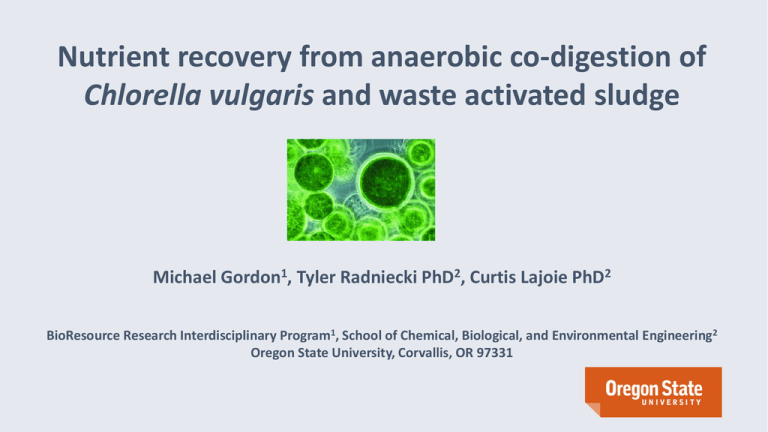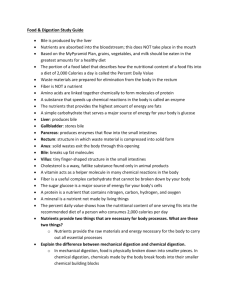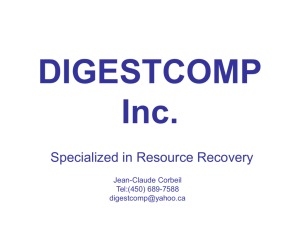Nutrient recovery from anaerobic co-digestion of Chlorella vulgaris Michael Gordon
advertisement

Nutrient recovery from anaerobic co-digestion of Chlorella vulgaris and waste activated sludge Michael Gordon1, Tyler Radniecki PhD2, Curtis Lajoie PhD2 BioResource Research Interdisciplinary Program1, School of Chemical, Biological, and Environmental Engineering2 Oregon State University, Corvallis, OR 97331 Biofuels • Renewable energy sourced from biomass • Ideally carbon neutral • Policy mandated http://green.blogs.nytimes.com • Energy Policy Act 2005, Energy Independence and Security Act 2007 • Renewable Fuel Standard- 38 billion gal by 2022 climatetechwiki.org greenwoodresources.com iipdigital.usembassy.gov Algal Biofuels • Unique advantages of algal biomass • lipid dense: up to 70% dry wt • High area productivity (1.25 kg m3/day) energytrendinsider.com • Doesn’t require arable land • Water source flexibility solixbiosystems.com Algal Biofuels Chisti et al., 2007 Algal Biofuels • Large scale production requires substantial inputs of nutrients • “Nutrients”= Nitrogen and Phosphorus • 45 kg Nitrogen and 4 kg Phosphorus / 1000 kg biomass • Nutrient inputs economically sustainable? Rock Phosphate mnmtraders.weebly.com Phosphorus is non-renewable Phosphorus • A rise in biofuel production is expected to increase competition with industrial agriculture for limited resources Viacarri, 2009 Anaerobic Digestion • Proposed as a means of nutrient recovery and recycling • Digestion releases nutrients from biomass into solution for later recovery • Proven technology at scale • Enhanced energy yield from CH4 production • Provides a way to manage large quantities of residual biomass Stahlbush.com Bill Chambers of Stahlbush Island Farms Anaerobic Digestion Backyard-scale digester in Eugene, OR epa.gov Anaerobic Digestion • Widely used in wastewater treatment plants to treat sewage • Produces a nutrient rich effluent Robert Esch Sewage Coarse Filter Primary Settling Tank liquid Aerobic Growth primary solids slurry Settling Tank WAS Anaerobic Digester grow algae harvest effluent: liquid nutrient-rich algal debris anaerobic digester effluent: solids biogas drying glycerol lipid extraction lipids MeOH + NaOH methyl esters Research Goal: Quantify recoverable nutrients in liquid phase of anaerobic digester effluents Questions: 1. How does the digestion of algae compare to WAS? 2. Is co-digestion necessary to maintain digester performance? 3. Does the digestion of lipid-extracted cells differ from the digestion of whole cells? Hypothesis: digester performance and nutrient recovery will decline as the percentage of algal substrate increases, and, the digestion of lipid-extracted cells will result in lower digester performance and nutrient recovery when compared to whole cells Digester Breakdown Lab-scale batch anaerobic digesters • Constant loading rate of 2070 mg VS L-1 • Constant inoculum to substrate ratio of 5.8:1 • Substrate composition varies • *1 trial w/ whole cells and 1 w/ lipid-extracted algal debris Head space (N2) Inoculum: Corvallis WWTP Total Liquid =100 mL Buffered H20 Digester Substrate: Algae and or WAS Lab-scale batch anaerobic digesters Monitoring: pH, biogas, CH4, VS reduction Nutrient quantification Influent Hach® vials Total N Total P Nutrient quantification Effluent Centrifuge Pellet Hach: Total N, Total P Supernatant Ion Chromatography: PO3 NO2 Colorimetric: NH4 Results • Biogas production provides a measure of digester activity • Substrate loading standardized by volatile solids (VS) content • Sig. diff. in biogas yields b/w WAS control and 100% lipid-extracted C. vulgaris (p<0.001) • respective cumulative biogas yields 657 and 408 mL g-1 VS • 85 % CH4 Results • As the % of algae increases, a greater reductions in biogas were observed • [1-(Treatment biogas(mL) / Control biogas (mL)]*100 • Sig. diff. in biogas yields b/w WAS control and 100% lipid-extracted C. vulgaris treatments (p<0.001) Results • Recoverable nutrients are those that end up in the supernatant • Reductions in biogas correlated with a decline in recoverable nutrients • Nutrient recovery is more efficient with WAS than with C. vulgaris Sig. Diff: nitrogen: p<0.02, phosphorus: p<0.001 Results • [1-(Treatment nutrients recovered (mg) / Control nutrients recovered (mg)]*100 • 100% C. vulgaris treatment sig diff than WAS control, N: p<0.02, P: p<0.001 • No sig. dif. b/w influent nitrogen in WAS control and 100% C. vulgaris treatment (p=0.8) • Sig. dif. b/w influent phosphorus in WAS control and 100% C. vulgaris treatment (p=0.04) Results: Co-digestion necessary? • Ammonia inhibition not observed • NH4 concentrations well below inhibitory levels (1500 ppm) • Future experiments: shock loading Results: Whole cells vs lipid-extracted cell debris? • Whole cells produced significantly more biogas than lipid-extracted cells (p<0.001) p<0.001 Results: Whole cells vs lipid-extracted cell debris? • Nutrient recovery from whole cells was more efficient than lipid-extracted p<0.001 for both N and P Conclusions • Increasing concentrations of C. vulgaris resulted in lower biogas production • Decrease in biogas production correlated to a decline in recoverable nutrients • Anaerobic digestion of algal debris as a means of nutrient recovery is possible though not as efficient as nutrient recovery from waste activated sludge • More data is needed to determine the relationship between % of algal substrate and recoverable nutrients • More precise analytical tools are needed to quantify nutrients in sludge Acknowledgements • Support provided through OSU’s USDA funded Bioenergy Education Project • Collaborators: Brian Kirby and Xuwen Xiang • City of Corvallis wastewater treatment plant • Advisors: Dr. Radniecki and Dr. Lajoie





